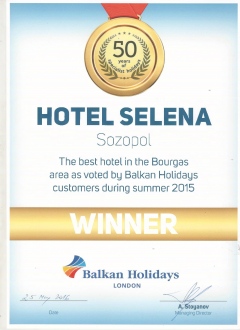The Village of Brashliyan
The Village of Brashlyan
 The village kilometres 14 kilometers north-west of the town of Malko Tarnovo and about one hour drive from Sozopol. The population consists of 44 permanent citizens. The village is nestled among lush valley covered with oak and beech woods. In its vicinity, there are mythical meadows covered with dewy. Ever since your arrival in the
The village kilometres 14 kilometers north-west of the town of Malko Tarnovo and about one hour drive from Sozopol. The population consists of 44 permanent citizens. The village is nestled among lush valley covered with oak and beech woods. In its vicinity, there are mythical meadows covered with dewy. Ever since your arrival in the  architectural reserve of the village of Brashlyan, you will realise that you are in a very special place, and will start a real encounter with the past. Narrow streets, as if you can hear the echoing footsteps of former young men and women, two hundred annual rural houses, monuments of culture, an old church of the eighteenth century, the restored old church school.
architectural reserve of the village of Brashlyan, you will realise that you are in a very special place, and will start a real encounter with the past. Narrow streets, as if you can hear the echoing footsteps of former young men and women, two hundred annual rural houses, monuments of culture, an old church of the eighteenth century, the restored old church school.
- Church school - an architectural and cultural monument. It is in the annexe building of the church "St. Dimitar". The school was founded in 1871 after Bulgaria received independence of church functioning.
- "St. Dimitar" Church: In the past, the temple was dug in the ground and was surrounded by a wall about 2.50 meters high. The central interior space was dug to get more room.
- Ethnographic Museum is 150 year old building is preserved in its authentic form both externally and reg
arding internal regulations of the premises. In its architecture, it is a Renaissance house with stone ground and a wooden floor.
- Balyuvata house is an architectural and historical monument. It was built in XIX century. The plan of the house is typical of Strandzha residential architecture. The ground floor is of stone with two wooden sashes. The second floor is entirely built of wood.
- Agricultural Museum of Traditional Farming: It is dedicated to the traditional
agriculture of the Renaissance. In a specially built shed and around the courtyard, are exposed old agricultural tools used by Strandzha in the past sledge (similar to sledge tool for threshing). A stone mill for wheat swap hook (a wooden instrument that is pulled over the fingers at harvest), pàleshnik(tapered flat iron, which is fastened obliquely at the end of an old plough to cut the soil), devices for processing of flax and hemp will see even a small apiary.
- "St. Panteleimon": It is located 1 km south of Brashlyan along a tributary of Katun River. The chapel was completely rebuilt in 1996. There is a place with spring water called Ayazmata. It is very popular, and it is believed that the water has medicinal properties. Today, centuries-old trees near the chapel impress. Next to the chapel there is a recreation area - shelter with tables, benches and a fireplace.
- St. Petka Chapel: It is located about two kilometres east of Brashlyan. You can go to the chapel on a tourist route that starts from the village and leads to the area of Vajievo. St. Petka is worshipped in this region as a healer, so the spring of the chapel are attributed healing effects.
- St. Marina Chapel: Located at the eastern end of the village, the chapels d
edicated to St. Marina in Strandzha, were usually built in caves or on rock crevices.
Hot offers










